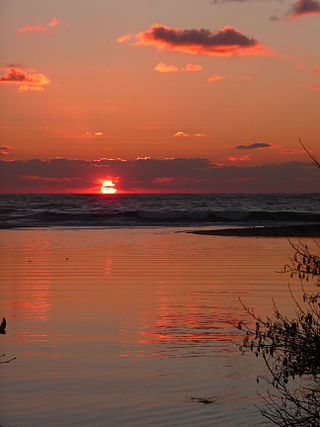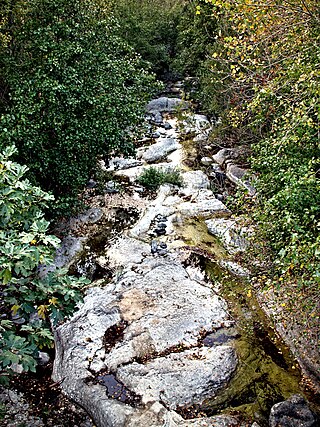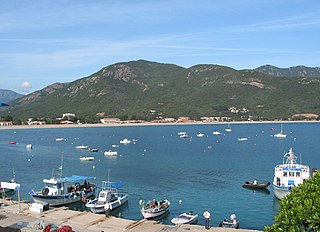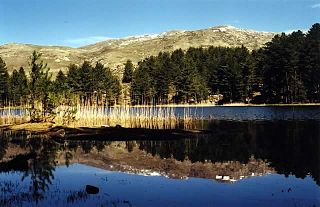
Ajaccio is the capital and largest city of Corsica, France. It forms a French commune, prefecture of the department of Corse-du-Sud, and head office of the Collectivité territoriale de Corse. It is also the largest settlement on the island. Ajaccio is located on the west coast of the island of Corsica, 210 nautical miles (390 km) southeast of Marseille.

Vico is a commune in the French department of Corse-du-Sud, on the island of Corsica.

Alata is a commune in the Corse-du-Sud department, on the French island of Corsica. It is within the metropolitan area of the capital Ajaccio.

Cargèse is a village and commune in the Corse-du-Sud department of France on the west coast of the island of Corsica, 27 km north of Ajaccio. As of 2017, the commune had a population of 1,325.

Asco is a commune in the Haute-Corse department of France on the island of Corsica.

Barbaggio is a commune in the French department of Haute-Corse on the island of Corsica. It is known for its wine, its scenery, and the prehistoric site of Strette.

The Liamone river is a river of Corsica, France. The river gave its name to the former French department of Liamone. In antiquity, it bore the Latin name Circidius.

The Gulf of Porto is a gulf of the Mediterranean Sea located on the western façade of the island of Corsica, France, well known for its dramatic coloration and rugged cliffs. The gulf is located within the department of Corse-du-Sud. The gulf and surrounding coast is part of the Regional Natural Park of Corsica. In 1983 the gulf was designated as a UNESCO World Heritage Site, encompassing the Calanques de Piana, Gulf of Girolata, and Scandola Nature Reserve, due to its outstanding scenery, rich avian and marine life, and maquis shrubland.

The Agriates Desert or the Agriates is an area of Corsica split between the micro-regions of Balagne and Nebbio in Haute-Corse.

The Étang d'Urbino is a coastal lagoon beside the Tyrrhenian Sea in the Haute-Corse department on the French island of Corsica.

The Fium'Albino is a small coastal river in the departments of Corse-du-Sud and Haute-Corse, Corsica, France. Its mouth opens into the Gulf of St Florent in the Mediterranean Sea on the west of the Cap Corse peninsula.

The Sagone is a coastal river in the northwest of the department of Corse-du-Sud, Corsica, France.

Sagone or Saone is a small seaside resort on the west coast of the island of Corsica in the commune of Vico. The settlement dates back to the 4th century, when a Roman villa was built there, with other buildings for slaves or peasants. A Christian church was built in the 5th or 6th century, later abandoned. A new cathedral was built in the 12th century, seat of the Roman Catholic Diocese of Sagone. The Genoese built a tower in the 16th century to defend Sagone against Barbary pirates. The cathedral had been abandoned by the 18th century, and the town was deserted. The tower was badly damaged in 1811 during an attack by the British. Today the village is growing again due to tourism.

The Liscia is a coastal river in the west of the department of Corse-du-Sud, Corsica, France.

The Cruzzini is a river in the center of the department of Corse-du-Sud, Corsica, France. It is a tributary of the river Liamone. The valley is isolated, heavily wooded, and surrounded by high and steep mountains. There is little tourism, and the population is poorer and older than in the island as a whole.

The Guagno is a river in the north of the department of Corse-du-Sud, Corsica, France. It is a tributary of the river Liamone.

The Santu River is a small coastal river in the department of Haute-Corse, Corsica, France.
The Alistro is a small coastal river in the department of Haute-Corse, Corsica, France. It enters the Tyrrhenian Sea from the east of the island.

The Col de Santo Stefano Corsican: Bocca di San Stefanu) is a mountain pass in the Haute-Corse department of Corsica, France. It is one of the main passes in Corsica, running between the massifs of Monte Stello to the north and Monte Astu to the south. It provides a route from the Saint-Florent region to the northwest and Biguglia in the eastern coastal plain.




















